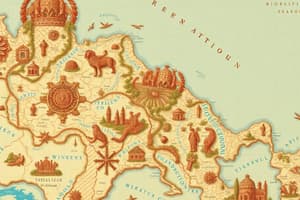Podcast
Questions and Answers
What is the main purpose of a cartographical map projection?
What is the main purpose of a cartographical map projection?
- To convert map features from a spherical surface onto a flat surface (correct)
- To display only political boundaries
- To enhance the aesthetic quality of maps
- To create artistic renditions of geographical features
Which of the following map projections preserves the correct area?
Which of the following map projections preserves the correct area?
- Cylindrical Projections
- Equal-Area Projections (correct)
- Azimuthal Projections
- Conformal Projections
What is a characteristic feature of Conformal Projections?
What is a characteristic feature of Conformal Projections?
- They preserve correct distances
- They represent the entire globe accurately
- They preserve correct shape over small areas (correct)
- They distort area significantly
Which projection method is easiest to understand and implement?
Which projection method is easiest to understand and implement?
What distinguishes Azimuthal or Planar Projections from other types?
What distinguishes Azimuthal or Planar Projections from other types?
Which process is used to create an Orthographic projection?
Which process is used to create an Orthographic projection?
Which type of projection would you use if preserving shapes over small areas is critical?
Which type of projection would you use if preserving shapes over small areas is critical?
In the creation of conic projections, what is the basic assumption made?
In the creation of conic projections, what is the basic assumption made?
Flashcards
Cartographic map projection
Cartographic map projection
A process that converts coordinates from a sphere or ellipsoid (Earth's shape) onto a flat surface.
Equal-area projection
Equal-area projection
A map projection that portrays all areas with their true size, regardless of shape distortion.
Conformal projection
Conformal projection
A map projection that preserves the shapes of small areas, but distorts the size of areas.
Conic projection
Conic projection
Signup and view all the flashcards
Azimuthal projection
Azimuthal projection
Signup and view all the flashcards
Cylindrical projection
Cylindrical projection
Signup and view all the flashcards
Orthographic projection
Orthographic projection
Signup and view all the flashcards
Stereographic projection
Stereographic projection
Signup and view all the flashcards
Study Notes
Introduction to GIS Cartographic Principles
- Geodesy is the science of determining Earth's size and shape.
- Early maps often depicted Earth as flat, but Aristotle (384-322 BC) understood Earth to be spherical.
- Aristotle roughly calculated Earth's circumference to be 45,500 miles (approximately 24,902 miles).
- Eratosthenes (around 250 BC) refined this calculation, using observations of sun rays to get a nearer estimate (approximately 25,000 miles).
- Modern GPS satellites now accurately determine Earth's shape.
- Earth's surface is irregular, not perfectly oblate.
- A geoid is a smoothed representation of Earth's topography.
- An ellipsoid (oblate spheroid) is typically used for mapping because it's simpler and more accurate for most purposes.
Presentation Outlines
- Geodesy and Earth's size
- Map projections
- Map distortion
- Planar projections
- Conic projections
- Cylindrical projections
- Reasons for using projections
What is a Map Projection?
- A map projection is a mathematical process to represent a spherical or ellipsoidal Earth on a flat surface.
- This process leads to unavoidable distortions in shape, area, distance, or direction.
- Various projections exist, each designed for specific purposes, some in widespread use.
Types of Map Projections
- Planar/Azimuthal
- Conic
- Cylindrical
- Equal-area projections
- Conformal projections
Main Projection Classes
- Planar/Azimuthal projections
- Conic projections
- Cylindrical projections
Planar Projection
- The simplest form uses parallel rays to project a globe onto a flat surface (orthographic).
- Other variations (like stereographic) adjust ray positions.
Conic Projections
- The Earth is wrapped around an imaginary cone, which is then "unfolded" to produce a map.
- Rays are traced onto the cone and then the surface is unfolded into a flat map.
Cylindrical Projections
- The Earth is wrapped around an imaginary cylinder.
- Rays are traced onto the cylinder, then the cylinder is "unfolded" to produce a flat map.
Distortion of Map Presentation
- Distortion in maps is inevitable due to the transition from a spherical/ellipsoid shape to a flat surface.
- Every projection has a characteristic distortion pattern.
- Cones and cylinders are used to create surfaces with zero curvature when representing the earth.
Problem of Curvature of the Earth
- Transforming a curved surface to a flat one results in unavoidable distortion.
- Distortion impacts distance, direction, area, and shape.
Unavoidable Distortion
- All map projections introduce errors.
- Distortion can affect conformity (consistent scale), shape, direction, area, and scale relative to Earth's surface.
Summary
- Geodesy has a long history, and Earth is not flat; it's an oblate spheroid.
- Maps are projected, converting 3D to 2D.
- Map projections are planar, cylindrical, or conic, and all have associated distortions.
Studying That Suits You
Use AI to generate personalized quizzes and flashcards to suit your learning preferences.




